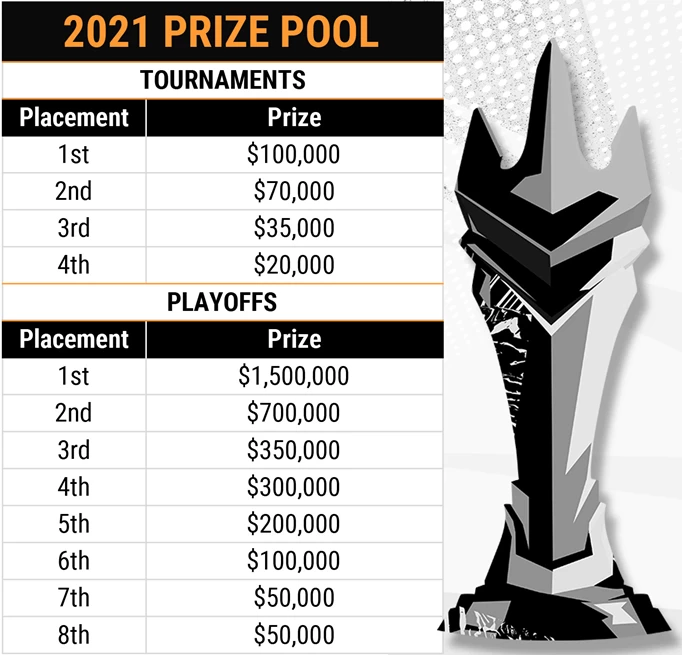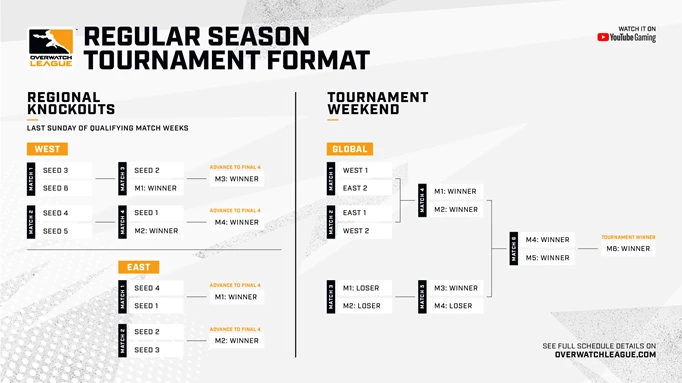Opinion: The New Overwatch League Format Is The Best It's Ever Been

We finally know. Starting April 16, Overwatch League is back with its fourth season, hitting it off with the Battle for Texas between the Dallas Fuel and the Houston Outlaws at 12 pm PT (3 pm ET / 8 pm GMT / 9 pm CET), followed by the San Francisco Shock against the Los Angeles Gladiators. On top of a much-improved field and an expectation of higher parity, there are $4,250,000 (~£3,000,000) reasons to care.
Now that we have a clear vision of the season format and its scheduling, it allows us to weigh up the impact and implications of those changes. After considering these points carefully, while also asking around for impressions from teams within the Overwatch League, I can only come to the conclusion that this is the best wholistic season format yet and by a significant margin, with only a couple of obvious downsides inherent in any system. Which changes have the Overwatch League announced, and why do I think these work so well?
Scheduling and tournament changes
According to a press release by the Overwatch League, the regular season will run for a total of 208 matches, cut up in four tournament cycles called May Melee, June Joust, Summer Showdown, and Countdown Cup. Teams will play a total of 16 regular season matches each, which comes down to four qualifying matches for each tournament.
Once again, the League has been split into West and East, with twelve teams competing in North America and Europe and eight teams playing in Asia. Conveniently for viewers, matches have been scheduled in a way for them to always start at 12 pm PT (3 pm ET / 8 pm GMT / 9 pm CET) in the West and at 6 pm KST (4 am ET / 9 am GMT / 10 am CET) in the East which should help with developing an intuitive feeling for when matches are on during the weekend.
Each regular-season match win adds a so-called “League point” to a team’s total, which will determine overall league standing and will finally determine the qualified teams of the season playoffs. On top of winning regular-season matches, the winner of each respective tournament will receive three League points, the runner-up two League points, and the third-place one additional League point.
The average team will play significantly fewer matches than in the previous season, with every regular-season match becoming a lot more important than in past seasons not only for the valuable League points, but also in order to qualify for the tournaments in which additional League points and prize money) is up for grabs. For fans who try to catch as much Overwatch League as possible, either their social life or their FOMO will thank the League for this decision.

 Click to enlarge
Click to enlargeThe best six teams in the West and the four best teams in the East - as determined by the score of their qualifying matches - will be pitted against each other first in regional playoffs, from which two contenders of each region emerge to the tournament finals. The two teams from North America will fly out to Hawaii in order to be able to compete against the two Asian teams on manageable ping.
The 208 regular season matches are split up into 160 qualifier matches, leaving 48 matches for the respective tournaments or twelve matches per tournament. For the Western teams, a bye for the two top seeds in the first round of the bracket will net big benefits to the teams going through the qualifying stages with a clean 4-0 scoreline while seed three to six have to play each other in the first round. The winners of those matches will then play the top seeds for a ticket to Hawaii. For Asia the first seed is put against the fourth and the second against the third seed of the qualifying stages, with the winners moving on to the international bracket.
Once the Western teams are in Hawaii, teams will be playing a double-elimination bracket to determine the winner of the tournament. Presumably, nobody wants to take on travel and fly home from Hawaii, having only played one match in the tournament, so a double-elimination bracket adds a life-line and also treats the viewers to additional high-quality matches. It bears pointing out that travel to Hawaii is likely to be a competitive disadvantage for Western teams when Asian teams play from their home facility. During times of a pandemic, this is hardly avoidable if you want international crossover events and they are likely of particular interest in order to get more mixing and mashing of the two fan bases, helping fans from the East to get invested into teams in the West and vice versa.

 Click to enlarge
Click to enlargeA lot of breaks
The Overwatch League has introduced a significant amount of breaks into each team’s regular-season schedule. During the three week qualifying period, teams will play only on two of those weekends. Not only does this introduce a natural break week into the schedule, which serves player and staff well-being, but it also gets rid of the possibility of a team having to prepare for two opponents while one or both opponents only had to prepare for them. This had been the case in previous seasons and had on occasion been raised as an issue of competitive integrity, as it gave opponents significant advantages in preparing for matches.
Moreover, teams will also have a break after each tournament concludes, giving the Western teams in Hawaii a chance to fly back. Additionally, the League announced that new balance patches would only ever be introduced in this post-tournament cycle break week, giving teams the chance to prepare for the new realities of a balance patch.
Here, an arguable weakness of the schedule shows, as teams who don’t manage to qualify for the tournaments will only be actively competing in two of the four play-weeks during the regular season. At worst, teams who don’t manage to qualify for a single tournament will only be competing in eight weeks for the entire year (assuming that not every team will be invited for the season playoffs). If you’re a fan of one of the worst teams in Overwatch League, you won’t have to see them suffer often.
Voices from within Overwatch League teams have advised that while they generally agree that the season had to be slowed down, the low amount of games and high amount of breaks might be too much of a de-escalation.
Hero Pools
Hero pools are back but in a much less impactful way than in season 3, as the Overwatch League will only run them for the full tournament cycles of June Joust and Countdown Cup, with May Melee, Summer Showdown, and the season playoffs being played without any hero pools restrictions. Heroes with a play rate of higher than 10% in the previous no-Hero Pool competition will be eligible to be banned, and from said pool of heroes, a selection of two DPS, one support, and one tank will once again be taken out of play. Heroes banned in the June Joust may not be banned against for Countdown Cup.
During season 3, Hero Pools had been a polarising feature that promised to deliver meta diversity on weekly and later bi-weekly cadence. However, coaches and players around the Overwatch League had advised that the feature had added too much additional pressure and volatility to their day-to-day, making it a challenging system to work.
With these changes, Hero Pools will still deliver frequent variety on top of the regular balance patches, which will hit after each tournament cycle. In effect, we can expect these changes to enact a meta switch every four to five weeks. Whether or not this is enough to reach the equilibrium of entertainment for the viewer base and workability for the Overwatch League’s professionals remains to be seen. In my opinion, the solution allows for highly entertaining meta sophistication towards the end of the competition peaking right during the tournament playoffs, allowing for a great viewership experience.
A juggling ineffable complexity
The number of variables the Overwatch League front office had to juggle when making these decisions is likely to be brain-breaking, and due to the uncertain nature of the world in 2021, the League has reserved itself the possibility to be flexible with potential changes across the season.
More than the incorporation of a plethora of variables, from COVID-19 related challenges, to market realities, to player and staff mental health, and just so much more, the intent that stands out is to listen to feedback provided by both the community and the professionals having to work in the system. As such, almost every change is recognisable as an answer to a common issue raised in past seasons. Just like in their change of demeanour towards content and social media interaction, the League has once again signalled that it’s more willing than ever to work with its community and its professionals and as a result, have created the most compelling and workable season format in its history. Add to that the upgrades teams have made across the league, and the following increase of competitiveness across the board and April 16 can’t come soon enough.
Images via Blizzard Entertainment